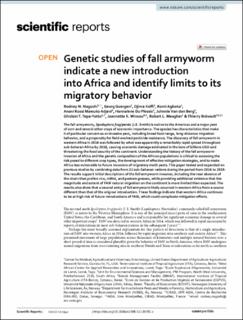| dc.contributor.author | Nagoshi, Rodney N. | |
| dc.contributor.author | Goergen, Georg | |
| dc.contributor.author | Koffi, Djima | |
| dc.contributor.author | Agboka, Komi | |
| dc.contributor.author | Adjevi, Anani Kossi Mawuko | |
| dc.contributor.author | Du Plessis, Hannalene | |
| dc.contributor.author | Van den Berg, Johnnie | |
| dc.contributor.author | Tepa-Yotto, Ghislain T. | |
| dc.contributor.author | Winsou, Jeannette K. | |
| dc.contributor.author | Meagher, Robert L. | |
| dc.contributor.author | Brévault, Thierry | |
| dc.date.accessioned | 2022-07-21T09:42:57Z | |
| dc.date.available | 2022-07-21T09:42:57Z | |
| dc.date.created | 2022-05-10T14:17:24Z | |
| dc.date.issued | 2022-02-04 | |
| dc.identifier.citation | Scientific Reports. 2022, 12 1-12. | en_US |
| dc.identifier.issn | 2045-2322 | |
| dc.identifier.uri | https://hdl.handle.net/11250/3007489 | |
| dc.description.abstract | The fall armyworm, Spodoptera frugiperda (J.E. Smith) is native to the Americas and a major pest of corn and several other crops of economic importance. The species has characteristics that make it of particular concern as an invasive pest, including broad host range, long-distance migration behavior, and a propensity for field-evolved pesticide resistance. The discovery of fall armyworm in western Africa in 2016 was followed by what was apparently a remarkably rapid spread throughout sub-Saharan Africa by 2018, causing economic damage estimated in the tens of billions USD and threatening the food security of the continent. Understanding the history of the fall armyworm invasion of Africa and the genetic composition of the African populations is critical to assessing the risk posed to different crop types, the development of effective mitigation strategies, and to make Africa less vulnerable to future invasions of migratory moth pests. This paper tested and expanded on previous studies by combining data from 22 sub-Saharan nations during the period from 2016 to 2019. The results support initial descriptions of the fall armyworm invasion, including the near absence of the strain that prefers rice, millet, and pasture grasses, while providing additional evidence that the magnitude and extent of FAW natural migration on the continent is more limited than expected. The results also show that a second entry of fall armyworm likely occurred in western Africa from a source different than that of the original introduction. These findings indicate that western Africa continues to be at high risk of future introductions of FAW, which could complicate mitigation efforts. | en_US |
| dc.language.iso | eng | en_US |
| dc.publisher | Springer Nature | en_US |
| dc.rights | Navngivelse 4.0 Internasjonal | * |
| dc.rights.uri | http://creativecommons.org/licenses/by/4.0/deed.no | * |
| dc.title | Genetic studies of fall armyworm indicate a new introduction into Africa and identify limits to its migratory behavior | en_US |
| dc.title.alternative | Genetic studies of fall armyworm indicate a new introduction into Africa and identify limits to its migratory behavior | en_US |
| dc.type | Peer reviewed | en_US |
| dc.type | Journal article | en_US |
| dc.description.version | publishedVersion | en_US |
| dc.rights.holder | © The Author(s) 2022 | en_US |
| dc.source.pagenumber | 12 | en_US |
| dc.source.volume | 12 | en_US |
| dc.source.journal | Scientific Reports | en_US |
| dc.identifier.doi | 10.1038/s41598-022-05781-z | |
| dc.identifier.cristin | 2023159 | |
| dc.source.articlenumber | 1941 | en_US |
| cristin.ispublished | true | |
| cristin.fulltext | original | |
| cristin.qualitycode | 1 | |

